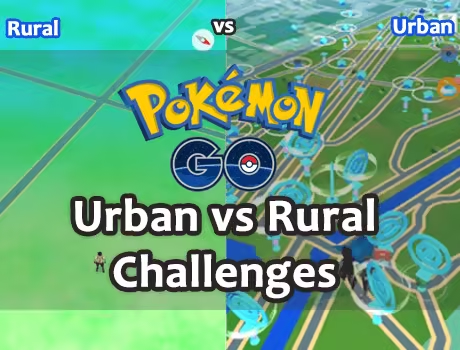Stuck in a rural area with barely any PokéStops or gyms? AnyTo helps you break free from location limits. With safe GPS movement, you can explore hotspots anywhere, join raids worldwide, and collect more spawns.
Let's be honest, Pokémon GO doesn't play out the same way for everyone. If you're in a big city, you're spoiled with gyms on every corner, PokéStops lining the streets, and wild spawns popping up nonstop.
Step outside to a rural area, though, and the story flips. Fewer PokéStops, fewer raids, and sometimes, no one around to team up with.
It's no wonder many rural players feel left behind. But here's the twist: urban trainers have their own set of headaches too.

In this piece, we'll break down the Pokémon GO urban vs rural challenges, talk about what rural players miss out on, and share some tried-and-true tips to make the grind a little less painful.
Quick Navigation
- Urban vs rural: How location shapes Pokémon GO gameplay
- What does it feel like to play Pokémon GO in cities?
- What is it like playing Pokémon GO in rural areas?
- How can rural trainers keep up in Pokémon GO?
- Does Niantic/Scoply make any efforts to improve rural gameplay?
- The bigger picture: What needs to change
- Modern solution for rural Pokémon GO players
- Conclusion: bridging the urban-rural gap is a long-term strategy
Urban vs rural: How location shapes Pokémon GO gameplay
If you've ever chatted with Pokémon GO players from different areas, you've probably heard the same frustration over and over: "This game just isn't the same for everyone." It's a statement rooted in experience.
For years, rural trainers have raised concerns about the lack of PokéStops, sparse Pokémon spawns, and fewer opportunities for raids or battles.
But to really understand the gap, we need to compare what it's like to play in a bustling city versus a quiet town. The difference isn't just numbers—it's the way the game feels, the pace at which you level up, and even the social side of playing.
1 What does it feel like to play Pokémon GO in cities?
Urban players live in what I'd call a "Pokémon playground." You get constant rewards and interactions, but it comes with its own small headaches.
Advantages of being an urban player
- PokéStops and Gyms everywhere. In a city, it's almost impossible to walk ten minutes without hitting multiple stops. That means more items, more XP, and more chances to spin those coveted Poké Balls.
- Frequent spawns and variety. Cities tend to attract higher spawn rates, including rare Pokémon during events. You're constantly running into new Pokémon without leaving your neighborhood.
- Raids and community events are accessible. With more trainers nearby, forming a raid group is easy. You rarely feel isolated when a Legendary raid pops up.
- Social interactions. Urban players often meet others in parks, at gyms, or in large events. This makes trading, battling, and even casual hangouts smoother.

Disadvantages of being an urban player
- Signal issues. Surprisingly, dense urban areas sometimes mess with GPS accuracy, especially in skyscraper-heavy districts, which may lead to GPS drift and "GPS signal not found" error.
- Event congestion. Legendary raids or community day spawns can become overcrowded, making timing and participation tricky.

Next, we'll dive into the flip side—the rural experience—and why it often feels like a completely different game.
2 What is it like playing Pokémon GO in rural areas?
While city players might feel like they're in a nonstop Pokémon party, rural trainers often have to strategize and make the most of limited resources. But don't get me wrong, there are unique advantages too.
Advantages of being a rural player
- Higher chances to shine in Showcases. If you catch an XXL Dudunsparce or a rare Pokémon that no one else nearby has, you can rake in serious rewards. XP and Stardust from these victories are no joke. Pairing it with a Lucky Egg and a Star Piece can give a huge boost to your progress.
- Guaranteed Gym rewards. Even if raids are scarce, placing a Pokémon in a Gym ensures you get 50 PokéCoins without relying on intense competition.

Disadvantages of being a rural player
- Gym stagnation. Once your Pokémon is in a rural Gym, don't expect it back quickly. I personally had my Umbreon stuck in a Gym for three months because no one challenged it. That's a long wait for your rewards.
- Sparse PokéStops and Gyms. Random Lures? Forget about it. In marginally populated rural areas, you can submit requests for new PokéStops, but the process relies on other players validating your submission. With few or no local players, your request might go nowhere.
- Fewer Pokémon spawns. Limited stops and spawns drop make events like Community Days exhausting. You'll need to walk further and plan better just to catch the same Pokémon that urban players stumble across casually.
- Limited local community. Trading becomes difficult, and accessing raid-exclusive Pokémon is much harder without nearby players.
- Slower progression. Completing research tasks, leveling up, and gathering items without spending real money is significantly tougher in rural zones.
- Raid challenges. The best raids, especially for Legendary Pokémon, are often out of reach unless you coordinate with players from outside your area.

In short, urban players enjoy a way better game experience than their rural fellows with more resources, more frequent spawns, and a larger community.
How rural trainers stay competitive in Pokémon GO
From the comparison above, rural players often have to put in extra effort to keep up with city trainers—sometimes feeling like a full-time job. Fewer resources mean you have to get creative—and sometimes spend a little—to bridge the gap.
Here's what rural trainers often adapt to stay competitive.
1 Compensating for fewer PokéStops and Gyms
- Mass add online friends
- Become a PokéStop and Gym creator
- Maximize daily gifts
- Walk everywhere
- Turn to Pokémon GO spoofers
Gifts from friends are a lifeline. They provide Poké Balls, potions, berries, and more without relying on local stops.
Rural trainers often turn to online communities like r/PokemonGoFriends to connect with dozens of players worldwide.
If you want long-term improvements, nominate new Wayspots in your area.
Unlock this feature by reaching level 38 (or 37 in some cases), then submit eligible spots like parks, churches, public art, and post offices.
Reviewing others' submissions on Niantic Wayfarer can also help prioritize your nominations.
Your buddy Pokémon can bring gifts daily, helping refill your inventory if stops are scarce.
Adventure Sync tracks steps even when the app is closed, allowing you to hatch eggs and earn buddy candy. When PokéStops are few, walking becomes your main source of rewards.
Many rural trainers risk using spoofing tools to reach resource-rich areas in Pokémon GO. The stakes are high—your account can be permanently banned if you're caught—but for some it's a low-cost way to access PokéStops, raids, and events that would otherwise require spending real money.
2 Overcoming limited Pokémon spawns
- Use Daily Adventure Incense
- Focus on event windows
- Visit nearby urban centers
This boosts spawns for 15 minutes while walking, ensuring you don't miss out on Pokémon even in empty areas. If you're low on Poké Balls, the game gifts you 30 to start.
Community Days and Spotlight Hours significantly increase spawn rates. Planning your play around these events maximizes candy, Stardust, and shiny chances.
Occasionally traveling to larger towns or cities lets you restock items, catch a greater variety of Pokémon, trade with more players, and join populated raid lobbies.
3 Participating in raids
- Use remote raid apps
- Host raids yourself
- Leverage rural Gyms
Tools like PokeGenie allow you to join raids from anywhere with a Remote Raid Pass. This opens the door to Legendary and high-level raid bosses you'd otherwise miss.
You can host a raid—if there's any nearby—using your in-person raid pass while remote players fill the lobby.
With less competition, holding a gym is easier. Collecting 50 PokéCoins daily from gyms can fund your remote raid passes or other in-game purchases.
In short, rural trainers constantly make strategic sacrifices—time, effort, sometimes money—to keep pace with urban players. It's a grind, but with smart planning, it's possible to stay competitive without being overwhelmed.
Does Niantic/Scoply make any efforts to improve rural gameplay?
For years, rural players have voiced frustration—and some have even quit the game—because Pokémon GO often feels stacked in favor of urban areas.
From Niantic's perspective, rural players are less likely to spend money: fewer gyms mean fewer raid passes bought, and smaller populations mean less participation in events. As a result, many gameplay updates and bonuses tend to prioritize city players.
That said, Niantic has made some moves to help rural trainers catch up.
In early 2025, the developers rolled out a global increase in Pokémon spawn rates, specifically targeting rural and remote areas. The Road to Unova event highlighted this change, with Niantic noting that Pokémon would "appear in even more places than before." For trainers who've struggled to see any spawns nearby, this was a welcome, if modest, improvement.

Another earlier feature designed with rural players in mind is Party Play. This system provides a damage boost in raids when players team up, making it easier for small groups to tackle tough raid bosses. For those living far from cities, where gathering large raid groups is tricky, Party Play offers a realistic chance to participate in raids and earn rewards.
While these changes are steps in the right direction, rural trainers still face challenges. Spawn density, gym accessibility, and local community size continue to influence gameplay heavily.
Niantic's efforts are helpful, but bridging the urban-rural gap remains a slow, ongoing process.
The bigger picture: What needs to change
Pokémon GO was built to get players outside and exploring, but maybe not that far.
Head into a forest, up a mountain, or down to the beach with the app open, and you'll quickly notice a frustrating truth: the game doesn't always reward your curiosity.
While urban areas are dense with PokéStops and gyms, natural or remote areas often have only a single stop at a viewpoint or a man-made sign. For a game built around exploration, this is a huge gap.
Incense was another area where rural players felt the pinch. Niantic's adjustments in the Season of Alola 2022 nerfed spawn rates from Incense, limiting a tool that rural trainers rely on heavily. When catching Pokémon is already harder in remote areas, why make it even tougher?

To truly improve rural gameplay, Niantic needs to tackle the deeper issues: resource generation, Pokémon spawns, and community engagement. Small steps like Daily Adventure Incense are helpful, but systemic changes are necessary. Here's what could make a difference:
- Rework item drops from gifts. Gifts are a key resource for rural players, but relying on friends can be inconsistent. Increasing item yield or introducing a "daily gift from the professor" could ensure a steady flow of Poké Balls, berries, and potions for everyone.
- Extend Daily Adventure Incense benefits. Its 15-minute window is limiting, and walking dependence can be prohibitive. Options like longer durations, stackable bonuses, or multiple uses per day could help. Increasing the free Poké Balls when your bag is empty would also be a simple fix.
- Simplify PokéStop creation. Right now, you must reach level 38 to nominate new PokéStops—a tall order for rural players. Lowering this requirement or offering alternative nomination methods would empower communities to add points of interest locally.
- Introduce passive spawn points. Instead of relying solely on population density, roads, trails, or low-speed zones could automatically generate Pokémon spawns, giving rural trainers consistent encounters.
- Expand spawn points at low-density Waypoints. Many rural parks only have one or two approved Wayspots. Designating all approved Wayspots in low-density areas as special spawn zones could make trips more rewarding and encourage exploration.
- Gamify community building. Niantic could offer in-game rewards for forming local groups, hosting events, or participating in Wayfarer. This would encourage social engagement without putting all the burden on rural players.
By implementing these kinds of changes, Niantic could create a more equitable and enjoyable experience for rural trainers. Right now, many invest huge amounts of time and effort for fewer rewards, but with the right tools and system tweaks, the gap between urban and rural gameplay could finally start to close.
Modern solution for rural Pokémon GO players
Search 'how to play Pokémon GO in rural areas,' and you'll get endless threads, but most of them boil down to the key tips I've covered above.
If you're looking for a more ultimate solution to bridge the rural-urban gap, technology can help. Some may call it a Pokémon GO hack, but it quietly levels the playing field. One option is AnyTo, a Pokémon GO spoofer.
At its heart, AnyTo is a location changer designed to make Pokémon GO more accessible to everyone, no matter where they live or how mobile they are. It helps players explore the world in-game without being limited by their surroundings, offering a fairer way to experience what Pokémon GO is truly about: adventure, discovery, and connection.

- AnyTo offers multiple movement modes so players can adapt to different situations, including Teleport, Multi-Spot, Route Generation & Auto-Walk.
- Unlike basic spoofers that risk account bans, AnyTo uses Bluetooth-based connection between your device and computer to ensure smooth and secure GPS simulation.
- AnyTo stays compatible with the latest versions of Pokémon GO, Android, iOS, and Windows/macOS, meaning players don’t have to worry about patches breaking the app.
- AnyTo also includes a suite of Pokémon GO tools—like Raid Maps, PokéStop Maps, Gym Maps, and even Pokémon search filters—to help trainers plan smarter routes, find active areas, and join raids with minimal hassle.
Watch video tutorial of the best Pokemon GO hack for iOS and Android AnyTo:
Conclusion: bridging the urban-rural gap is a long-term strategy
Ultimately, the urban-rural divide in Pokémon GO is about more than just convenience. It's about access, fairness, and opportunity.
While Niantic has made some improvements, there's still work to be done to ensure that every trainer, regardless of location, can enjoy the full Pokémon GO experience.
For rural players, persistence, creativity, and strategic planning remain the keys to keeping up, and for the game itself, thoughtful, systemic updates could finally level the playing field.
The road ahead is long, but with the right mix of developer support and player ingenuity, Pokémon GO can truly become a game where adventure and reward aren't defined by your zip code.
-
Hyper Training Guide: Best Pokémon for Silver Bottle Caps in Pokémon GO
How does Silver Bottle Cap work in Pokémon GO? Which Pokémon should you use the Silver Bottle Cap on? Check out this ultimate Hyper Training guide in 2025!
8 mins read -
Mega Metagross Pokémon GO Debut: Best Moveset, Counters, Stats & Guide[2025]
Mega Metagross is finally making its debut in Pokémon GO next season! Learn how to get it, its best moveset, top counters, and key stats to dominate battles.
6 mins read -
How to Beat Dialga in Pokémon GO: Weakness & Best Counters [Raid Guide 2025]
Dialga returns as a Tier 5 Raid Boss in Pokémon GO this September! Learn Dialga's weakness, best counters, and how it compares to Origin Forme and Palkia!
10 mins read -
Pokémon GO Duraludon Guide: Debut, Stats, Weakness & Evolution
Dynamax Duraludon is making its Pokémon GO debut during the Steel Skyline. Learn the event details, Duraludon weaknesses, best counters, and how to evolve it!
8 mins read -
Pokémon GO Keldeo 2025: How to Get & Full Guide
Discover everything about Keldeo in Pokémon GO 2025. Learn how to get Keldeo, best moveset, strengths, availability, and tips to prepare for its return event.
5 mins read -
Ralts Evolution Pokemon GO: How to Get Gallade or Gardevoir
Catch, evolve, and power up Ralts in Pokemon GO! Learn how to get Gardevoir, Gallade, shiny Ralts, best movesets & nest locations with AnyTo.
4 mins read




















 AnyTo Discord Server
AnyTo Discord Server
Was this page helpful?
Thanks for your rating
Rated successfully!
You have already rated this article, please do not repeat scoring!